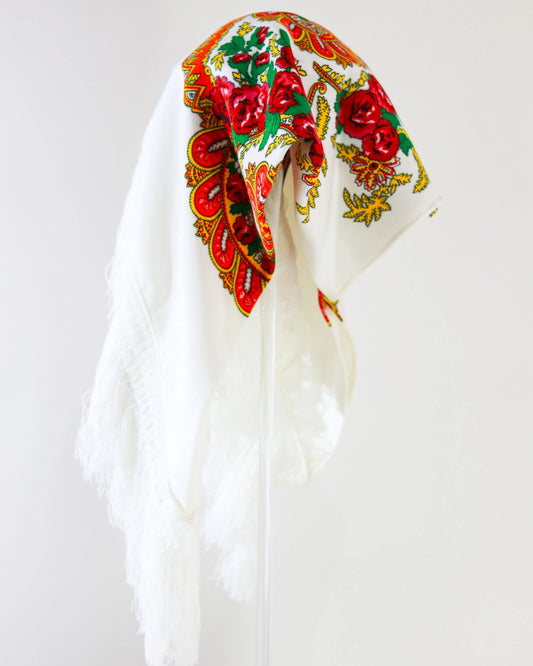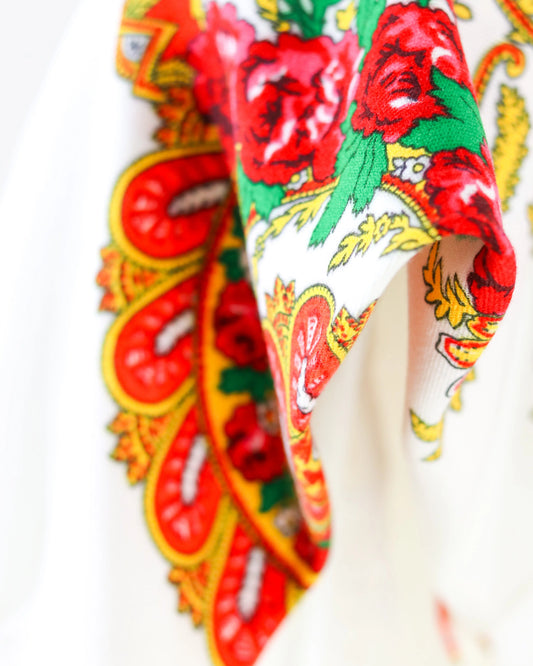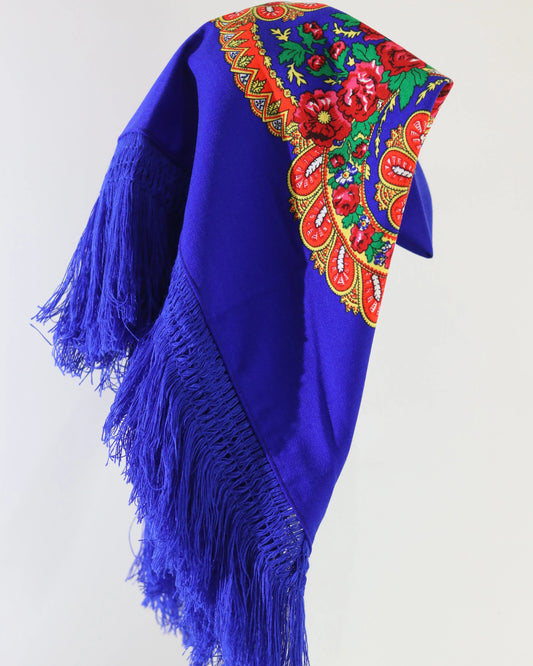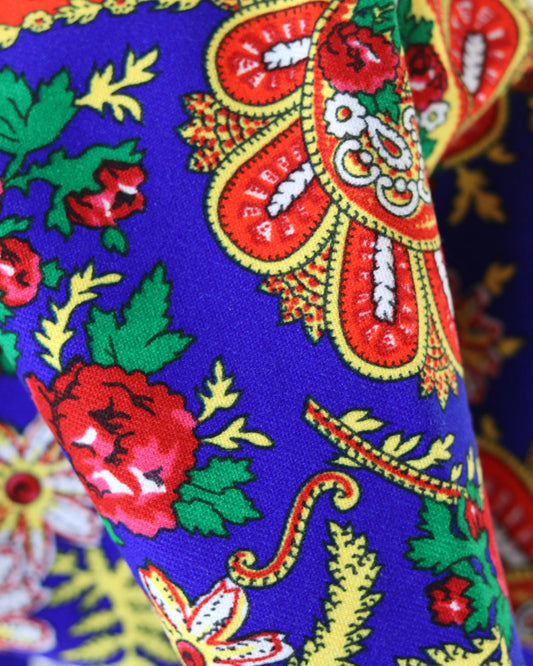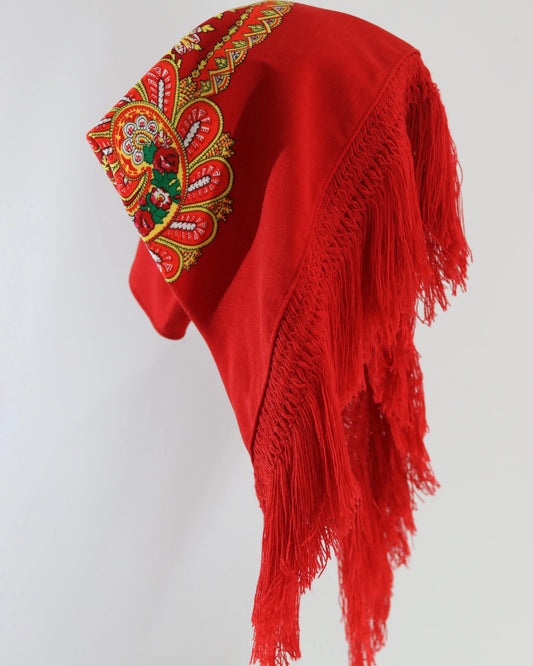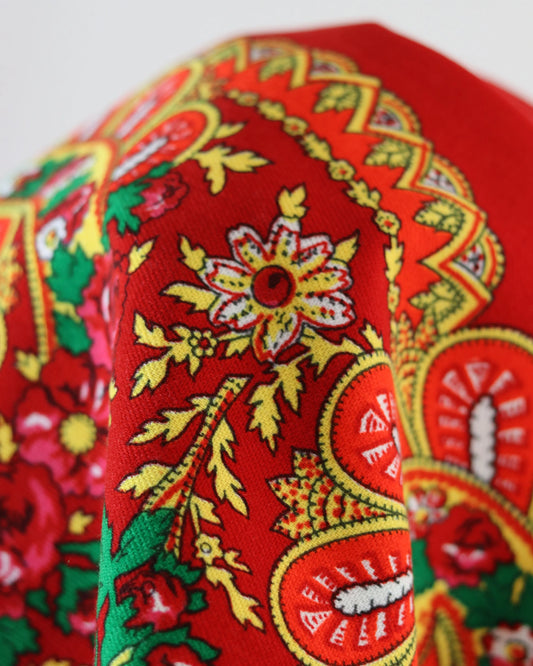Discover the art of traditional Viana scarves
Some people fall in love with Viana's traditional scarves at first sight. It's not just a matter of color or pattern. It's the texture of the taffeta under the fingers, the relief of the stitch catching the light, the vegetal cadence that runs through the cloth like music. It's an object of use and celebration, but also an emotional map of Alto Minho .
They bring together history, technique, craftsmanship, and symbols that have spanned generations. And they live on, on the shoulders of farmers, in the windows of certified artisans, in the workshops of the Costume Museum, and on the streets in August when Viana vibrates with Senhora d'Agonia. Looking closely at an embroidered scarf is like entering a rigorous visual language, which needs no captions to be recognized as Viana do Castelo Embroidery.
What makes a scarf from Viana
The scarves' identity isn't born from a single line, but from a series of very precise choices: fabric, lines, stitches, and composition. The result is robust, luminous, legible from a distance, and delicate in its details.
Essential features:
- Linen or cotton taffeta base, traditionally white or ecru.
- Thicker, brighter, No. 8 pearl cotton threads in a canonical palette of white, dark blue and red.
- Measured, well-defined stitches, avoiding heavy fillings.
- Organic compositions, dominated by stylized flowers, hearts and sinuous stems.
A board helps to fix the essentials.
| Element | Materials and execution | Effect on the scarf |
|---|---|---|
| Base fabric | Linen or cotton taffeta, 100% or 50/50 blend. White or ecru predominates. | Firm body that supports openings and relief. |
| Pearl line no. 8 | Bright, well-twisted cotton in white, dark blue and red. | Clean contours, light and volume without the need for satin stitch. |
| Simple sieve (fillet) | Removal of threads from the fabric and reinforcement of open meshes. | Geometric transparencies, lightness and rhythm. |
| Fleece stitch | Thick cord for contours and petals. | Motif enhancement, legible drawing, movement. |
| Wire-gripper | Viana's particular twist, closed contour, reverse with two parallel lines. | Distinctive sign, strong and recognizable contours. |
| Ant's eye | Small raised dot. | Decorative dotted, discreet textures. |
| Buttonhole and festoon | Finishing with openings and silhouettes, sometimes cutouts. | Scalloped edges, serrations, emphasis on the motif's boundaries. |
| Open hems and crochet | Occasional and formal uses, infrequent. | Specific finish when requested, but not a rule. |
In most pieces, monochrome dominates. Color, when present, doesn't scream; it speaks. And the embroidery breathes because the sieve opens the field to light.
The vocabulary of shapes: japoneiras, hearts and brambles
Viana's scarves speak the language of a garden. The key word is japoneira, the stylized camellia with round petals, repeated in perfect circles of six to twelve. The center is usually worked in a sieve, with a cord marking the edge. Each japoneira is a little sun.
Along with it appear:
- Hearts that can appear alone or in pairs, sometimes containing other hearts. They are declarations of affection, devotion, and promises.
- Wavy stems, the blackberries, that stitch together the composition and support paired leaves. Between the curves appear tendrils, clusters, and berry-like balls.
- Teeth, small rods along a motif, creating a vibrant halo.
Everything points to a nature charged with meaning. Red speaks of joy and strength, the blue of the Atlantic and the sky, the white of the purity and clarity of linen. This is not a naturalistic flora. It is a flora of memory, polished to become an emblem.
How the tradition was born and how it grew
Its origins lie in the homes of the farmworkers of Alto Minho . They were the ones who drew, wove, and embroidered, transforming home-made linen and wool into festive attire. The scarf, worn on the head or shoulders, gained its own identity at the same time that the Viana costume established itself as a local reference.
In the early 20th century, this home-made activity found a public stage. In 1917, the Nossa Senhora d'Agonia Fair showcased pieces embroidered by village women from the municipality, with designs applied directly to the cloth, without rigid molds. D. Gemeniana Branco's name became associated with the organization of these first exhibitions and the impetus given to workshops that brought together embroiderers.
The following decades brought local expansion and increased visibility. Between the 1940s and 1950s, in a climate of exaltation of regional arts, Viana assumed a central place on the map of folklore, presented in exhibitions, processions, and publications. Experiments with colored fabrics, in blue or red, emerged, without displacing the predominance of white and ecru.
With urbanization and the decline in everyday use of the garment, production cooled off from the 1960s onward. The scarf went from everyday life to the folk group stage, to the museum display, to annual festivals. This shift didn't diminish it. It cemented its place as an identity marker.
In the new century, the municipality strengthened its preservation and transmission process. The application for a geographical indication and formal certification completed a cycle: they defined materials, stitches, finishes, and rules of authenticity. Today, there are accredited artisans, technical notebooks, institutional exhibitions, and a public that recognizes what is genuine.
Synthetic timeline:
- 19th and early 20th centuries: domestic practice linked to clothing.
- 1917: first public exhibitions and organization of workshops.
- 1940–50: national affirmation in exhibitions and processions.
- 1960–70: decline in everyday use, reinforcement in folklore.
- 2005–2012: application for and consolidation of certification and geographical indication.
Between pilgrimages and stage: the current life of handkerchiefs
The month of August makes the scarf a protagonist. During the Feast of Our Lady of Agony , the procession and ethnographic procession multiply patterns, cords, and sieves. Farmers walk up and down the streets with bright scarves draped over their laps, and the entire city of Viana is reflected in these embroideries, especially through the traditional Viana scarves.
There's a special moment: the Festa do Traje (Costume Festival), an annual parade that since 1919 has celebrated and explained traditional dress, featuring the meadela scarf as one of its main expressions. The parishes display variations, the red of Areosa dominates the posters, and groups present bridal, steward , work, and party attire. The scarf, in these scenes, ceases to be an adornment and returns to a language of expression.
Outside of August, the calendar is packed. Museums host craft workshops, schools host studios, and folklore groups organize themed exhibitions. Recently, initiatives like "90 Years – 90 Scarves" have combined memory and technology to showcase the evolution of drawing and stitching. It's a project that appeals to both children and adults and has a real impact on the continuity of the technique.
Authenticity: How to Recognize a Certified Scarf
The eyes train. There are subtle signs that distinguish a well-made piece, within tradition , from a rushed approximation.
Quick checklist:
- Fabric: Linen or cotton taffeta feel, firm base, with visible fibers. Avoid synthetic or very thin bases.
- Line: soft shine and relief of pearl No. 8, without fuzz. Classic, well-saturated colors, without garish variations.
- Stitches: Clean sieve, regular stitches. Cast-on stitch with consistent cord. The broken thread can be identified on the back by the two threads together.
- Design: Well-proportioned Japanese oak, hearts, and brambles. Halo teeth with lively but regular spacing. Organic compositions, not rigid geometric ones.
- Finishing: Firm scallops and buttonholes, correct hems. Crochet only when provided and with discretion.
- Certification: accredited artisan label and reference to geographical indication when applicable.
Warning signs:
- Indiscriminate use of satin stitch and cross stitch over large areas.
- Fine, matte, or synthetic threads that sink into the fabric.
- Generic patterns without recognizable japoneiras, or hearts with designs foreign to the Minho repertoire.
- Careless reverse, with loose loops and loose finishes.
The color code and what it says
The limited palette doesn't limit, it liberates. Three colors are enough to convey feelings and belonging.
- Red: celebration, passion, joy. In certain contexts, it was the preferred color of the most eye-catching pieces and of wealthy farmers.
- Dark blue: serenity, sea, night. It conveys sobriety and elegance, often used in contrasting compositions on a light base.
- White: purity and light. It's the tone that, on a white or ecru base, creates a bas-relief effect, playing with shadows and pearlescent shine.
Tradition recognizes specific colors of the base fabric during fashionable periods, but the heart of the Viana scarf remains faithful to this chromatic tripod.
Learn to embroider in the Viana style
Beginners need a method. The technique is demanding but clear. A brief guide helps you get started with the first stitches with precision.
Step by step:
- Fabric selection: linen taffeta or heavy-weight cotton. Wash and iron the fabric before scratching.
- Materials: needles suitable for the thickness of the pearl no. 8, pearl thread in classic colors, fine-tipped scissors, hoop if you prefer stability.
- Design: Select traditional motifs. Start with a simple Japanese plant with six petals, a curved heart, and a stem with paired leaves.
- Basic stitches: Practice simple sieve stitch on a small strip, practicing removing and reinforcing threads. Then, practice the cast-on stitch for outlines and the yarn over stitch for embroidering a motif.
- Rhythm: Move from the center outward, respecting the logic of the lines connecting the elements. In notched or haloed movements, maintain a regular cadence.
- Finishing: Short, firm backings and secure hems. Avoid excessive knots and crisscrossing.
Tips:
- Work in good light and gradually increase the scale of the japoneiras.
- Photograph the back. A clean back is a quality school.
- Compare with certified parts. The eye is trained by comparison.
Uses with respect to tradition
The meadela scarf is part of a costume, but it also finds its place in contemporary everyday life, as long as it is treated with respect.
Balanced ideas:
- In a festive context, wear it on the shoulder with a plain dress, letting the embroidery do the talking.
- At home, an antique piece can be framed with UV-resistant glass and placed out of direct sunlight.
- For gifts, choose certified pieces and include a note about the artisan and the embroidered motifs.
Avoid assemblies that distort the design or permanently bend the sieve areas. And don't apply old parts to items subject to heavy wear, such as bags or shoes.
Taking good care: cleaning and maintenance
Proper care lasts decades.
- Cleaning: Hand wash in cold water with mild detergent. No bleach. Rinse without wringing, pressing with a towel.
- Drying: flat surface, in the shade. Reposition gently to avoid deforming the sieve.
- Ironing: inside out, with a protective cloth, at moderate heat. Never over the sieve without interposition.
- Storage: Wrapped in acid-free paper and wrapped in a cotton bag. Avoid airtight plastic.
- Inspection: Twice a year, check for signs of moisture, mold, or pests. Air out on a dry day.
Very old pieces with sensitive fibers benefit from consulting a textile conservationist. Prevention is an investment.
Viana, a center among centers
The scarves interact with other Portuguese traditions of embroidery and openwork lace. The technical similarity doesn't dilute the personality. The trinca-fio, the japoneira, and the cartography of brambles and serrations create a recognizable signature.
Seeing a collection of regional embroideries side by side at national fairs or exhibitions helps one appreciate the uniqueness of Viana. This coexistence strengthens bonds: each technique illuminates the other, and the country's diversity is highlighted.
Who makes and certifies the traditional Viana scarves?
Today, there is a network of municipally accredited artisans, who excel in preserving handicrafts. Historic shops and workshops open to the public feature new pieces with up-to-date technical records. The Viana Costume Museum documents collections, hosts workshops, and publishes studies that preserve the history of Viana's traditional scarves and their manufacturing methods.
Municipal projects, educational programs, and events in institutional spaces keep the chain of transmission alive. Geographical indication and certification aren't bureaucratic. They guarantee that what reaches visitors respects the materials, stitching, and design required by tradition .
Because handkerchiefs still move us
The answer lies in the details. The subtle shine of pearl, the shadow cast by a sieve, the curve of a bramble that seems to breathe. It lies in the hands that learned from other hands and in the pride of wearing a scarf that tells where you come from.
Pieces like these aren't just beautiful. They connect people to places, unite time, and give meaning to celebration and nostalgia. In Viana do Castelo , a traditional scarf is never just an accessory. It's a gesture of belonging passed down from generation to generation, stitch by stitch, with the same joy with which the Japanese women unfold their fabric.

